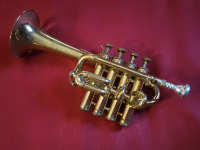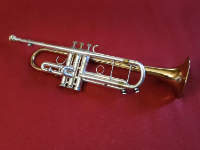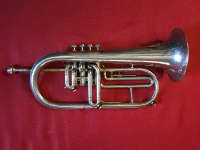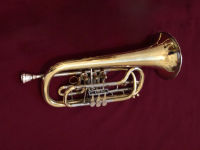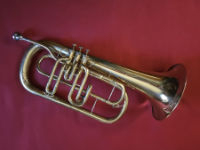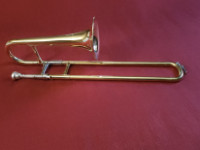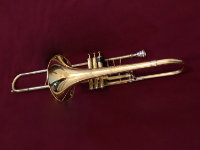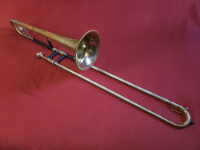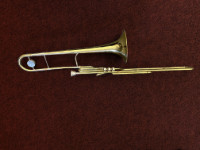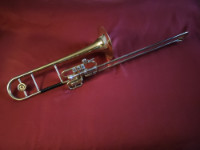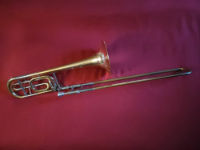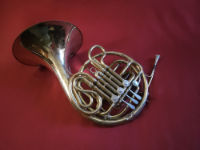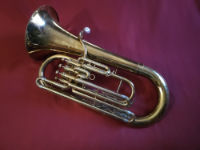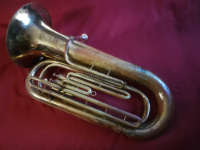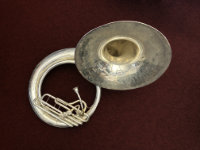What the heck IS that thing?
A field guide to instruments you may see and hear at a performance of The Brass Pack
The Brass Pack relies on—and revels in!—a variety of brass instruments, some of which may be unfamiliar to some listeners. (If that’s you, don’t feel bad. Some of them are unfamiliar to our own rhythm players, who do their best to ignore the shenanigans up front in the horn section.) But fear not, novice brassophiles! The Brass Pack is here to explain and educate as you take your first tentative steps on the path to brass nerd-vana.
Visual index • The basics • Rounding out the section • Oddities • Brass FAQs
Visual index
Click or tap the picture of the instrument you wish to identify… or use the links above to move to a particular section of this page. Or, of course, you can just scroll down.
The basics
We’ll start with the basics, two of the most popular and familiar brass instruments: the trumpet and the trombone. They are at the core of the brass family: If you were in band in school, or if you’ve ever seen a performance of a jazz big band, full symphony orchestra, concert band, or marching band, you’ve seen and heard these instruments in action. They are also essential in many jazz, pop, and rock horn sections—including The Brass Pack, which uses two trumpets and two trombones as the starting point for its horn section.
Trumpet
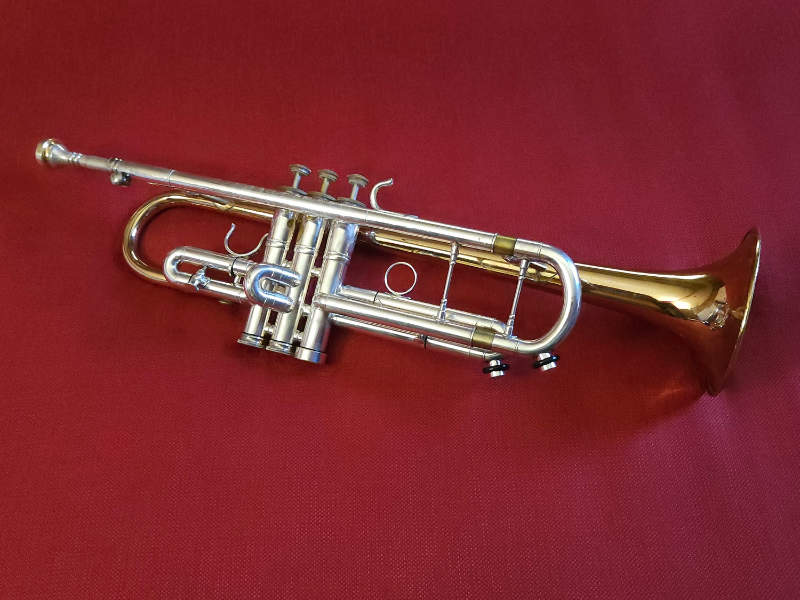
B-flat trumpet. Photo by Bill Ash
The trumpet is arguably the most common and best-known of the brasses; if you stopped a stranger on the street and asked them to think of a brass instrument, they would most likely think of a trumpet. Actually, first they would most likely think you were annoying and perhaps insane, but then they would most likely think of a trumpet. (Ignoring, for the moment, people who would think of a saxophone. Even though saxophones are made of brass, they are not considered members of the brass family. Rather counter-intuitively, they’re woodwinds. [Why?])
The late jazz trumpeter Maynard Ferguson famously called the trumpet “God’s own instrument” (well, it’s famous among trumpeters, anyway). The trumpet often is the lead voice of its section or ensemble, thanks to its soprano (technically mezzo-soprano) range and potential power and projection—although, much to some people’s surprise, in the hands of a competent player it is also quite capable of playing softly and sweetly.
The standard trumpet in most countries is in B-flat [Huh?], but trumpets are made in a number of keys. Two of the more popular alternatives to the B-flat are the C trumpet, the standard for many classical trumpeters; and the piccolo trumpet, which is half the size and pitched an octave higher than the B-flat.
Among musicians, the joke about trumpeters is that they are a bit obnoxious because they think they’re better than everyone else in the band, especially the other trumpeters. Of course, any trumpeter will tell you this is merely a joke—and not a very good one—which completely fails to take into account the actual superiority of said trumpeter. Conversely, anyone else who works with trumpeters will claim it’s no joke at all and is completely true. To date, members of The Brass Pack have been unable to reach a consensus on this subject. But they would be wise to remember that a trumpeter handles the band’s payroll.
Trombone
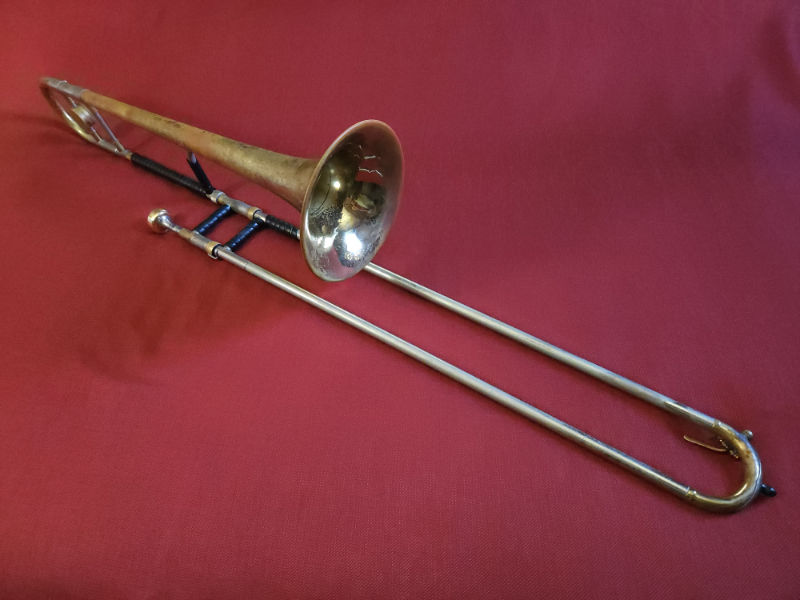
Tenor trombone. Photo by Bill Ash
The trombone may be the most distinctive member of the brass family—and maybe even all the orchestral instruments—due to its slide. Whereas other brasses use several (typically but not always three) valves to change pitch, trombonists move a long slide. Both the slide and valves are means of changing the length of the tubing of the instrument, and thus the note being played. Both methods have advantages; valves can be faster, but a slide can provide more precise fine tuning.
The slide was invented long before valves; around 1450 the trombone—then called a sackbut—essentially achieved its modern form. Conversely, valves for brass instruments weren’t invented until the early-to-mid 1800s; only then would the rest of the brasses begin to resemble their modern counterparts. Trombonists will tell you that the inventors of the trombone got it right from the start, and haven’t really needed to rework the design much. Other brass players may tell you that the trombone’s unimproved design has fallen centuries behind the rest of the brass section. They may even cast comparable aspersions about trombone players.
The tenor trombone—far and away the most common variant—is pitched in B-flat an octave below the trumpet and an octave above the tuba. It blends well with trumpets and other brasses, and actually blends well with many other instruments. This “plays-well-with-others” characteristic, and the fact that there are soprano, alto, tenor, and bass trombones, has led to a number of different trombone-based ensembles through the years, such as the trombone choirs used in the Moravian Church, Urbie Green’s 21 Trombones recordings, and Kai Winding’s recordings with four trombones plus a rhythm section. The Brass Pack frequently performs several of the Winding arrangements.
Rounding out the section
The trumpet and the trombone are certainly not alone in most brass sections. Depending on the size of the ensemble, the style of music they perform, and perhaps the availability of players and/or instruments, it’s fairly common to encounter the following instruments:
Bass trombone • Euphonium • Flugelhorn • French horn • Piccolo trumpet • Sousaphone • Tuba • Valve trombone
Bass trombone
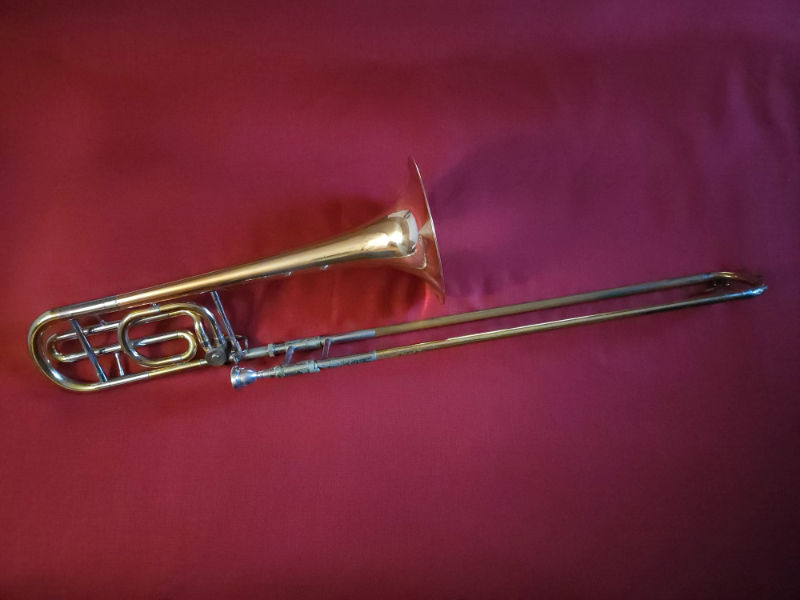
Bass trombone. Photo by Bill Ash
The bass trombone looks and is played much like the standard tenor trombone. However, the bass trombone has extra tubing, accessed through one or more “trigger” valves controlled by the player’s left hand, that enable it to play lower, and with more facility in the low register, than the tenor trombone. Bass trombones also have larger bells and slightly wider tubing (that is, a larger bore) than tenor trombones. This gives bass trombones a heavier, “bass-ier” sound.
Orchestral and big band trombone sections typically include one bass trombone, with the rest of the section playing tenor trombones. For the most part, The Brass Pack only uses bass trombone when all the horns are playing trombones.
Euphonium
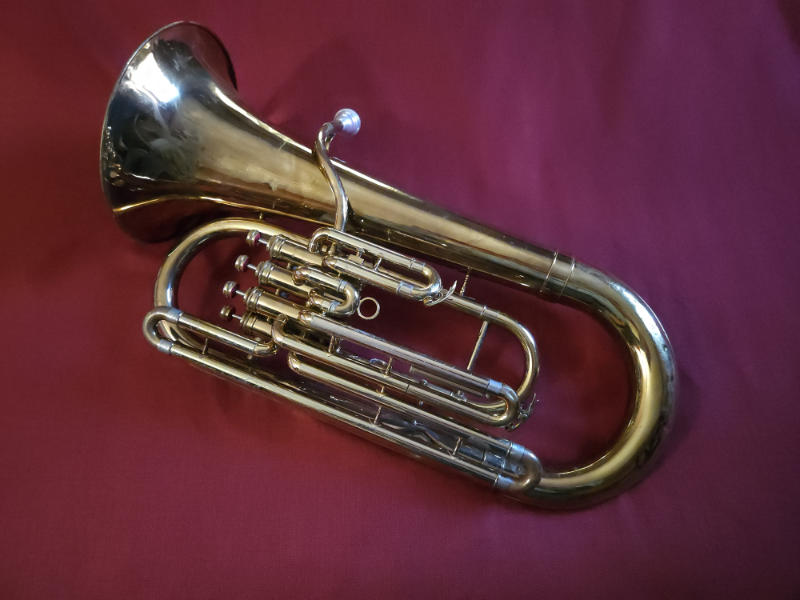
Euphonium. Photo by Bill Ash
The euphonium can be described several ways. Sonically, the relationship between the trombone and the euphonium is analagous to the relationship between the trumpet and the flugelhorn: the euphonium is a darker, mellower counterpart to the trombone. Visually, it resembles a small tuba, which arguably it is: it’s half the size (and an octave higher) than a standard tuba and shares a similar form, with the bell usually pointing up rather than forward. It can also be considered a larger cousin to the flugelhorn, which it also is: twice the size and an octave lower, but shaped a bit differently since flugelhorn bells usually point forward. These relationships all hold because flugelhorns, euphoniums, and tubas share similar bore shapes and thus can be considered members of the same sub-family of brass instruments.
Euphoniums are very similar to baritone horns, which are perhaps better known due to their popularity in concert, marching, and school bands over the past century or so. Generally baritones have a slightly smaller and less tapered bore, and consequently a slightly brighter sound. But in many cases the difference is quite minor, and can depend more on factors such as the brand and model of the instruments, the individual players, and the mouthpieces they use.
Many euphoniums have four valves, rather than the three that are standard on the majority of brasses. Like the trigger on a bass trombone, the fourth valve facilitates playing in the lower register. It also is useful for controlling intonation of certain notes.
In The Brass Pack, we find the euphonium can be a compelling solo voice, as well as a marvelous companion to flugelhorns, resulting in a dark, plush sound.
Flugelhorn
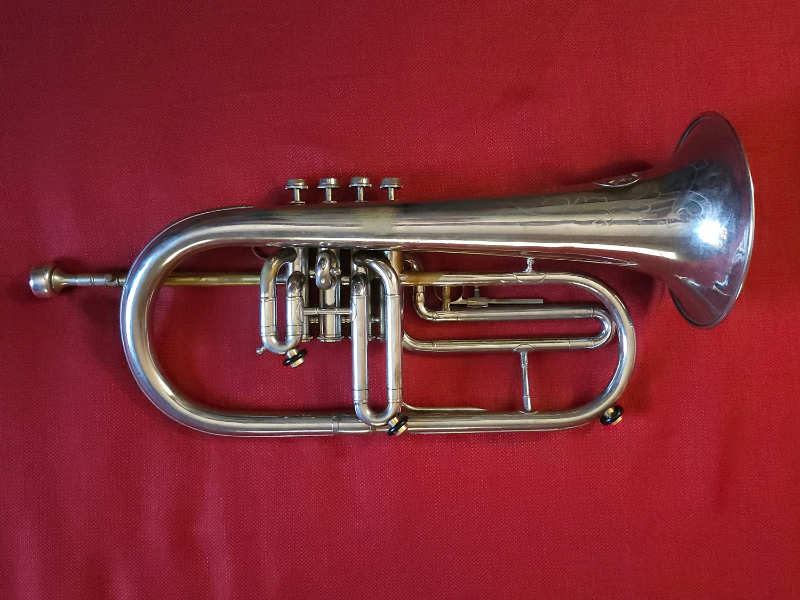
Flugelhorn in B-flat. This one has four valves; most have three. Photo by Bill Ash
The flugelhorn (also spelled flügelhorn, fluegelhorn or flugel horn) resembles the trumpet in general shape, size, range, and playing technique, and in fact is a common double for trumpeters. However, the flugelhorn has a different, more tapered bore shape (including a wider, more gradually tapered bell flare) which gives it a darker, mellower tone quality than the trumpet—somewhere between the sound of a trumpet and the sound of a French horn.
Thanks to its warm, smooth sound, plus the influence of flugelhornists like Clark Terry and Chuck Mangione, the flugelhorn has become very popular in jazz and commercial music. You’ll also find it in British-style brass bands, and in recent years it’s been making inroads into concert bands and orchestras as well.
The Brass Pack’s trumpeters make extensive use of the flugelhorn both for solos and in ensemble work. It’s an essential component of the band’s sound.
French horn
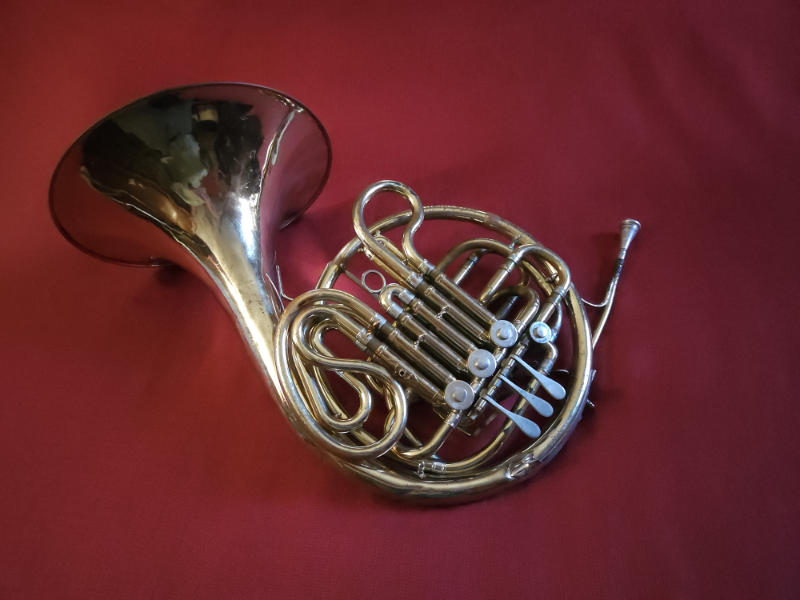
Double French horn. Photo by Bill Ash
The French horn, also just called the horn, is immediately recognizable by its rounded shape and widely flared bell. The horn is primarily used in classical music ensembles such as orchestras, concert bands, and chamber music. It sees much less use in jazz and pop music, although it long has been a favorite of film score composers.
The horn stands out from the rest of the brass family in a few ways. Besides its distinctive round shape, it’s the only brass instrument normally played with the player’s hand in the bell, and the only one that’s fingered left-handed. The horn is also the only instrument found in both a standard brass quintet and a standard woodwind quintet.
The usual key for a horn is in F, roughly midway between the trumpet and the trombone (which are both B-flat instruments). Many professionals play a double horn, which, through the use of an extra valve and additional tubing, manages to combine two horns, usually one in F and a higher one in B-flat, into one instrument. The higher horn aids in the playing of higher passages, which are difficult to perform cleanly on a single F horn.
Piccolo trumpet
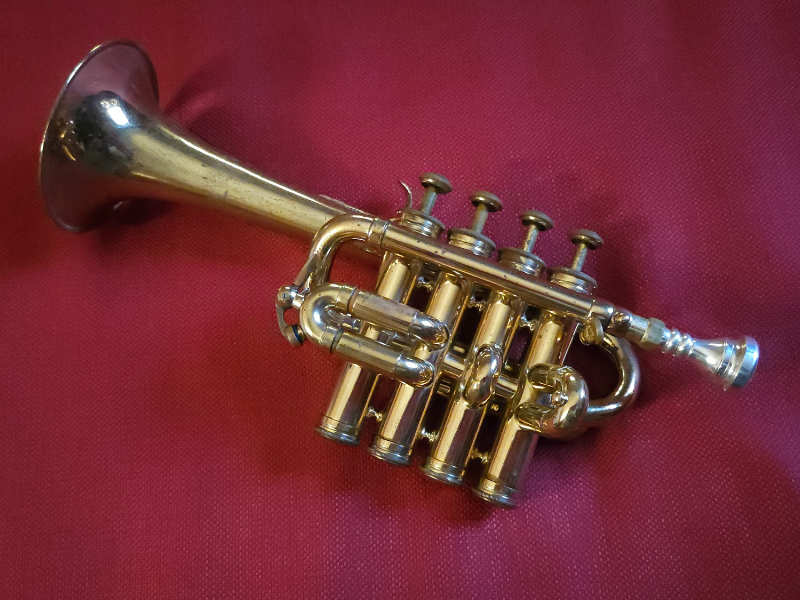
Piccolo trumpet in high B-flat. Photo by Bill Ash
Virtually unknown in the United States until the middle of the 20th century, since then the piccolo trumpet has become an important double for many trumpeters. Its pitch an octave higher than a standard B-flat trumpet makes high notes more secure than on its larger cousin, and gives it a light, bright, clear sound well-suited to baroque repertoire and certain other classical styles. It has also found a home in some jazz, pop, and rock situations—most famously, Royal Philharmonic Orchestra trumpeter David Mason’s piccolo trumpet solo on the Beatles’ Penny Lane.
Sousaphone
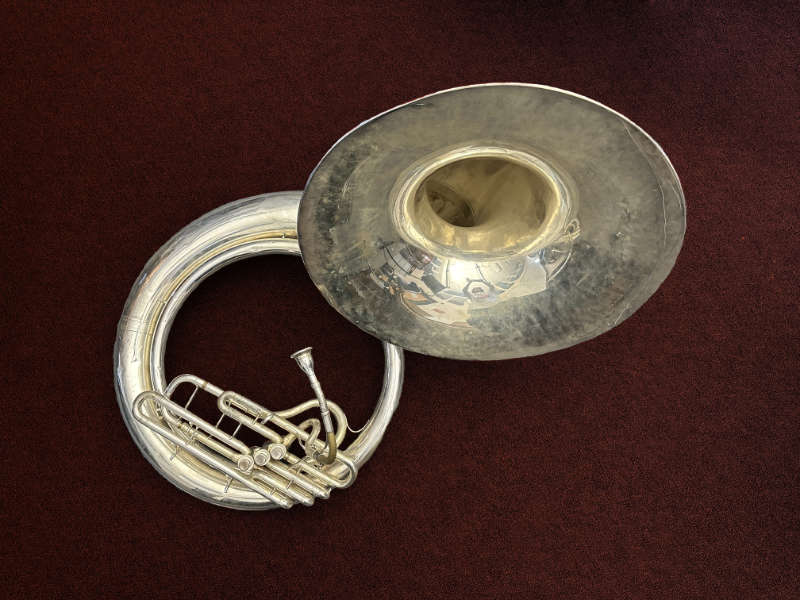
Sousaphone in BB-flat. Photo by Darrell Hendricks
If you’ve spent more time watching marching bands at football games than you have watching symphony orchestras at concert halls, then what you think of as a tuba may actually be a sousaphone.
Tubas are large, heavy instruments. A seated player can rest the tuba on their lap while they play, which relieves them from having to hold up the dang thing. But a standing or marching player has to carry the tuba all the time—and it’s not just a question of keeping it off the ground; it needs to be in just the right position that they can actually play it, and they need to use their right hand to work the valves, so the heavy lifting (literally!) of holding up the instrument falls to just their left hand and arm. Furthermore, the tuba has to be out in front of them; they can’t just let it hang down at their side.
At the request of composer and bandleader John Philip Sousa, after whom it’s named, the sousaphone was designed to be an alternative form of tuba that would be easier for marching musicians to carry and would project its sound over the rest of the band. This is achieved by wrapping the tubing in a big circle, with the player in the middle, and the instrument resting on their shoulder. This is much less taxing, and much better balanced, than carrying a conventional tuba. The bell of the instrument projects up and then forward, so the sound is indeed sent over the heads of the rest of the band.
Most sousaphones are pitched in B-flat, an octave below trombones and euphoniums. Besides marching bands, sousaphones are often used in New Orleans-style brass bands (which have their roots in marching bands) and in a pinch can be used just about anywhere a conventional tuba would be used.
Tuba
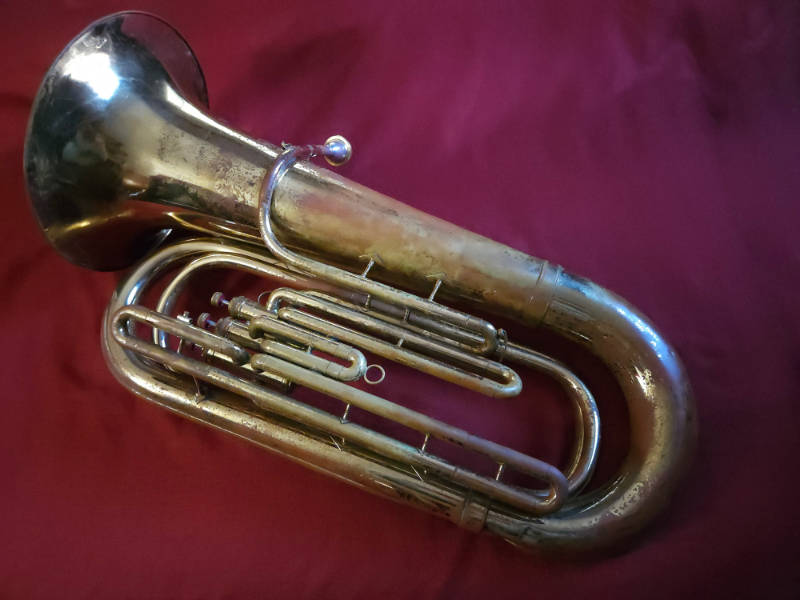
Tuba in double B-flat. Photo by Bill Ash
The tuba is the bass, or lowest—and therefore, the largest—member of the brass family. If the bass role in a group isn’t being filled by a string bass or bass guitar, there’s a good chance it’s being performed by a tuba or its close relative, the sousaphone.
Tubas come in several keys. The most common, and the lowest, is in BB-flat (“double B-flat”), an octave below a trombone. Going up from there, tubas are also made in C, E-flat, and F. An octave above the BB-flat is the tenor tuba in B-flat, which is essentially another name for a euphonium. Tubas can have three valves like most other valved brasses, but many have four, five, or even six valves. The extra valves offer alternative fingerings to improve intonation, and can assist in playing lower notes. (Tuba players love anything that helps them play low notes—that’s their specialty!)
In The Brass Pack, we sometimes use a tuba or a sousaphone to play the bass parts in Dixieland music.
Valve trombone
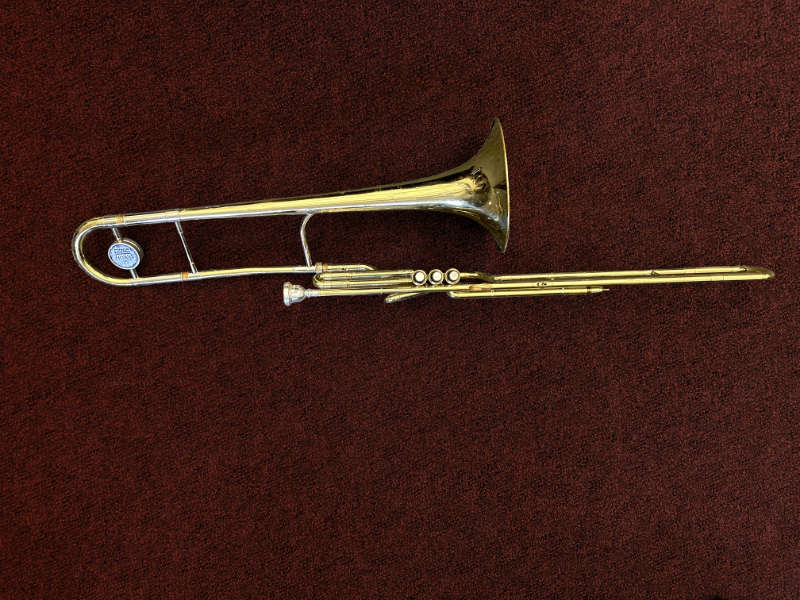
Valve trombone in B-flat. Photo by Darrell Hendricks
The valve trombone, as the name suggests, is a trombone that uses valves instead of a slide. Some may justifiably wonder why anyone would make a trombone without the quintessential feature that distinguishes the trombone from all other instruments, but in fact slide trombones and valve trombones have subtle differences in their sounds, and both variants have their uses.
Valve trombones are more commonly seen and heard in some other parts of the world than they are in the United States. Here they are primarily used in jazz, thanks to the influence of several important jazz valve trombonists including Juan Tizol, Bob Brookmeyer, and Rob McConnell. They are also used as a double by some trumpet players, since the valves allow them to play trombone parts using fingering technique they already have, rather than having to learn the slide.
Oddities
Trumpets and trombones? You see those just about everywhere, musically speaking. Flugelhorns, piccolo trumpets, tubas, French horns, euphoniums? You’ve probably encountered most of them at one time or another. But unless you are an afficionado of obscure brasses—or have been at a performance of The Brass Pack before—you probably haven’t seen or heard these instruments before. You may not even have known they existed!
Alto flugelhorn • Alto valve trombone • Bass flugelhorn • Slide trumpet • Soprano trombone • Superbone
Alto flugelhorn
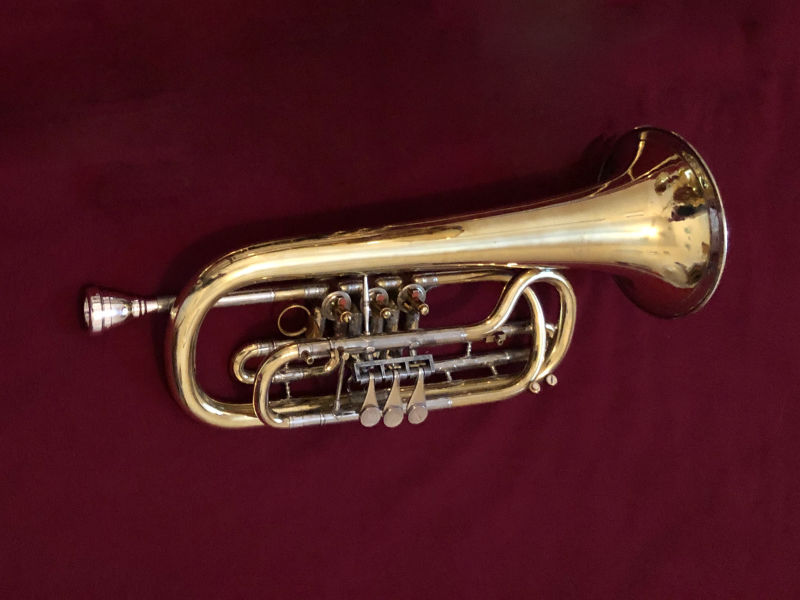
Alto flugelhorn in E-flat. Photo by Scott Reeves
The alto flugelhorn, as the name suggests, is an alto version of the flugelhorn, which is a soprano (or mezzo-soprano) instrument. While most flugelhorns are pitched in B-flat (a few are in C), alto flugelhorns are lower, in E-flat or F. This gives them a range and a timbre falling neatly and usefully between soprano instruments like trumpets and flugelhorns, and instruments an octave lower, like trombones and euphoniums—and of course, bass flugelhorns.
Alto flugelhorns are rare in the United States; they are somewhat more common in Europe. In the New York metro area—and probably well beyond—our own Scott Reeves is the foremost proponent and exponent of the alto flugelhorn.
Alto valve trombone
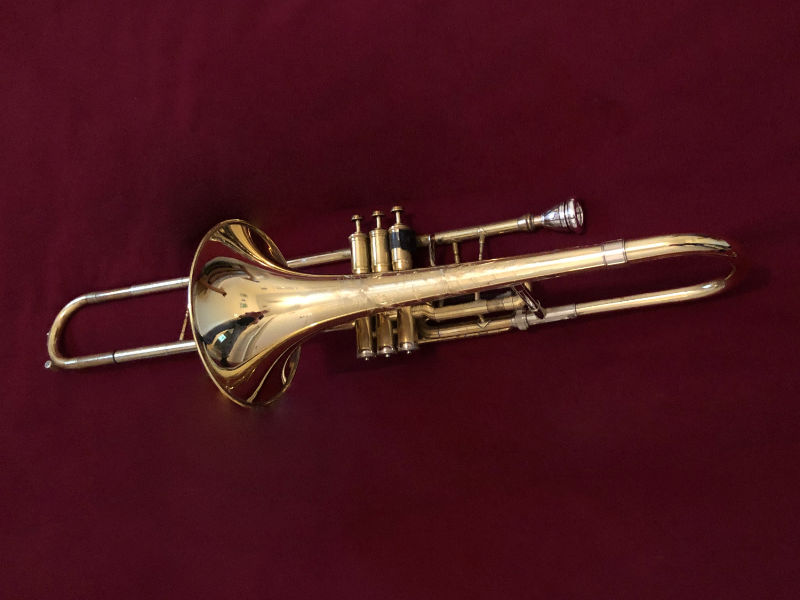
Alto valve trombone in E-flat. Photo by Scott Reeves
Among the less common variants of the trombone, you’ll find the alto trombone—a somewhat smaller trombone, pitched in E-flat a fourth higher than the tenor trombone and primarily used in some classical music—and the valve trombone. And if you combine those two? You get the alto valve trombone, a truly rare beast. But when Brass Pack trombonist Scott Reeves plays it, he makes a compelling musical argument in favor of the instrument.
Bass flugelhorn
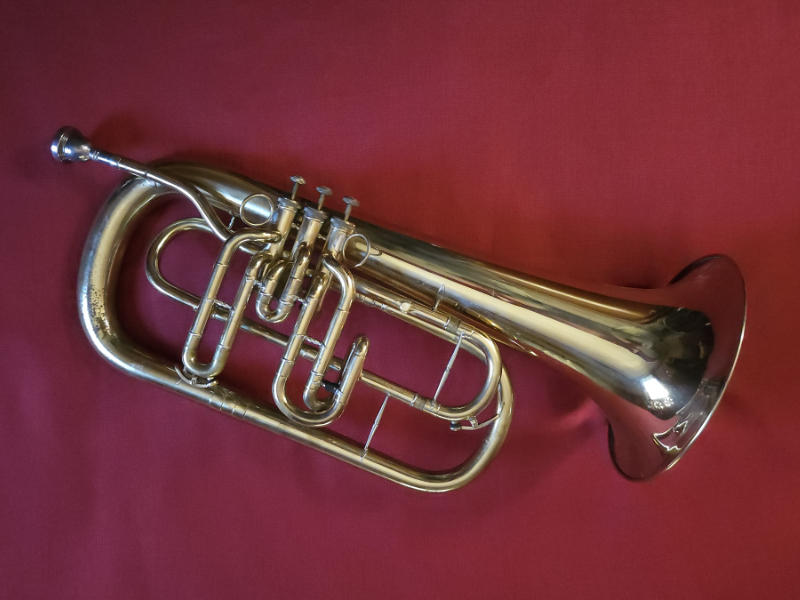
Bass flugelhorn in low B-flat. Photo by Bill Ash
The lowest member of the flugelhorn family is the bass flugelhorn, pitched in low C or B-flat an octave lower than the standard flugelhorn. This puts it in the same register as the trombone and euphonium. Bass flugelhorns are most often used in brass bands in certain countries in Europe, and are rare in the United States. However, they are very similar to marching baritones and marching euphoniums, which are fairly common here in marching bands.
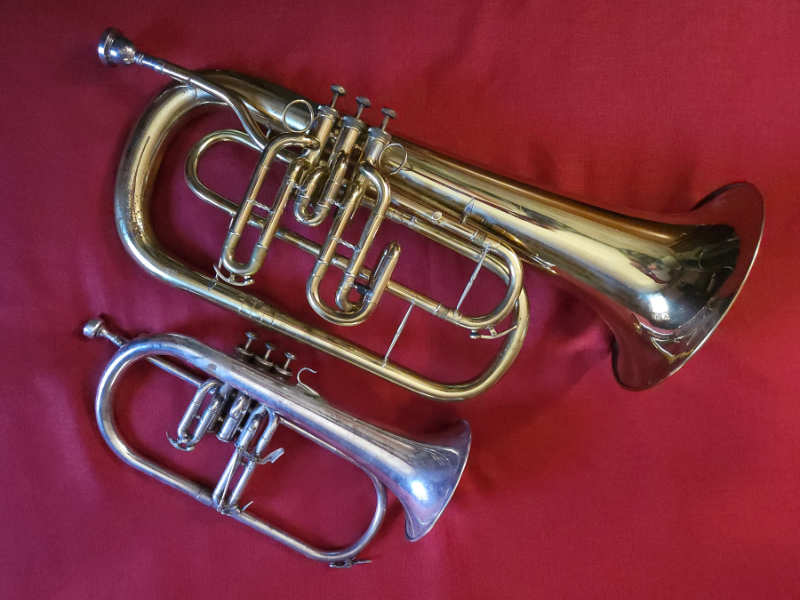
Size comparison of bass flugelhorn (top) and a standard mezzo-soprano flugelhorn. Photo by Bill Ash
Slide trumpet
Soprano trombone
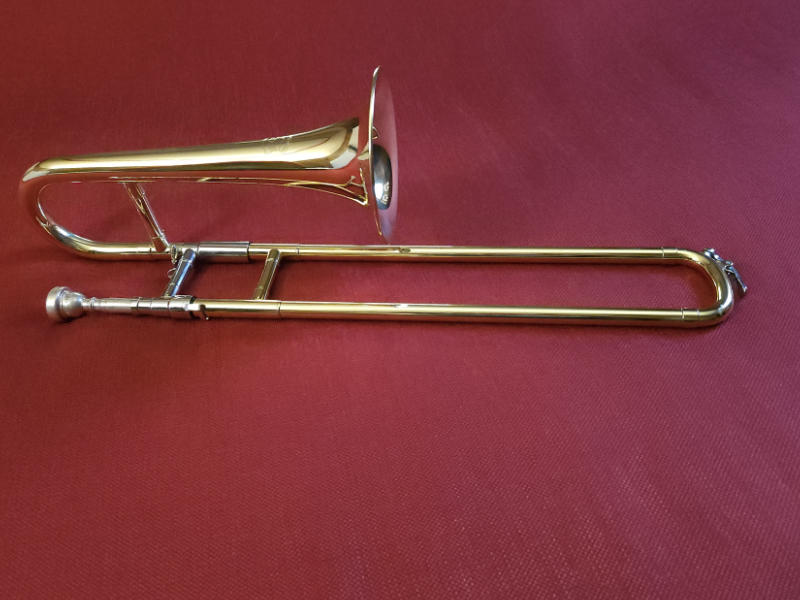
Slide trumpet (or soprano trombone) in B-flat. Photo by Bill Ash
What do you call an instrument that looks like a trombone and has a slide, but is the size of—and plays in the same register as—a trumpet?
If you’re a trumpeter, you call it a slide trumpet. If you’re a trombonist, you call it a soprano trombone. (Most others don’t know what to call it, and may not care.) Both names are accurate: it is a trumpet that uses a slide instead of valves, and it is a soprano version of a trombone.
The slide trumpet / soprano trombone has been around a long time; trumpets with slides were tried around the same time as the first trombones. Somewhat more recently (1923), there is a photograph of King Oliver’s Creole Jazz Band featuring Louis Armstrong, early in Armstrong’s career. In it, Armstrong is seen holding a slide trumpet as if he were playing it, but there is not much evidence (e.g. recordings or first-person accounts of seeing him play it in performance) that he actually did play the slide trumpet to any real extent. It seems to have been primarily a novelty for him.
As it was for Armstrong, the slide trumpet / soprano trombone seems to have been a novelty for most of the players who have experimented with it. However, a few have gone beyond that, developing real facility with the instrument and exploring its capabilities. Two notable contemporary examples are trombonist Wycliffe Gordon and trumpeter Steven Bernstein.
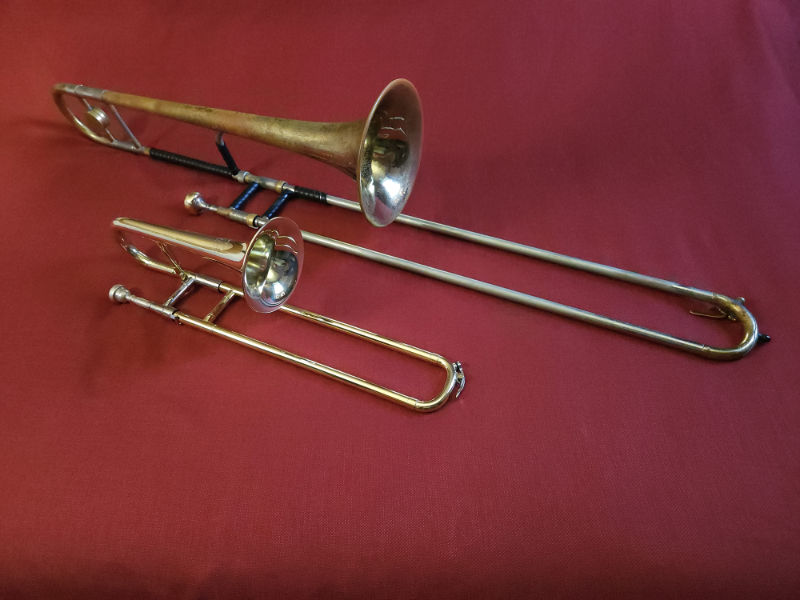
Size comparison of tenor trombone (top) and slide trumpet. Photo by Bill Ash
Superbone
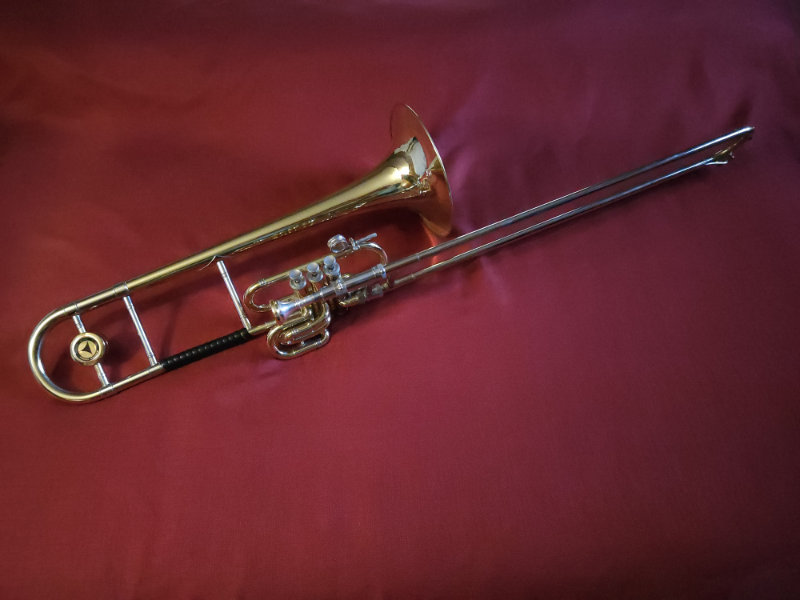
Superbone. Photo by Bill Ash
For trombonists who have trouble choosing between a slide trombone and a valve trombone, the superbone, also known as the double trombone, combines both instruments into one. It features a conventional slide and a set of valves; the player can chose either mechanism on the fly, or even use both at the same time.
The superbone per se was developed in the 1970s by Holton Musical Instruments with input from jazz trumpeter (and trombone doubler) Maynard Ferguson, who is the artist most closely associated with the instrument and used it on a number of recordings and in his shows. However, the double trombone has roots going back a century or so earlier; Holton’s and Ferguson’s main contribution might have been coming up with a catchier name and popularizing the instrument among Ferguson’s fan base.
While it’s still a specialty instrument, the superbone / double trombone continues to maintain a niche market, and several companies now make them. They are mostly used by jazz performers.
Brass FAQs
- What makes an instrument a brass instrument?
- Why are some brass instruments in different keys? What does that even mean—can’t they play in any key?
- What does the “bore” of a brass instrument refer to?
- What does it mean for a musician to “double”?
- Will I see all of these instruments at every performance of The Brass Pack?
What makes an instrument a brass instrument?
Well, that’s obvious. Brass, right?
Wrong.
While most brass instruments are indeed made of brass, that is not the determining factor. “Brass” instruments can be made of other metals such as silver or nickel; some are even made of plastic! Conversely, instruments such as saxophones are made of brass but are not considered brass instruments. (Saxophones are woodwinds!)
So what’s going on here?
The terms “brass” and “woodwind”, while still mostly accurate, are historical holdovers from an earlier time. Instruments are actually categorized according to how sound is produced on those instruments. In brass instruments, sound is produced by the player’s lips buzzing into a cupped mouthpiece as the player blows air through them. The instrument then amplifies and refines that sound, turning something that starts out sounding like a duck call into a grand, glorious sound.
Why are some brass instruments in different keys? What does that even mean—can’t they play in any key?
To answer the last question first: Yes, modern brass instruments can play in any key.
If you consider a trumpet without valves, or a trombone without a slide, then you have a bugle. Bugles cannot play in any key; a given bugle can only play in one key, and not even all the notes of that key—basically just the notes of one chord. A bugle in G, for example, plays the notes of a G chord.
So the key of a brass instrument is the key of the bugle it would be if it didn’t have valves or a slide. Thus a trumpet in B-flat plays only the notes of a B-flat chord if you don’t press any valves down.
Changing the pitch of a brass instrument requires changing the length of its tubing; that’s what slides and valves are for, and why they are necessary to play all the notes in the scale. But significant changes to the length of a brass instrument’s tubing also alter the timbre, or tone quality, of the instrument’s sound. Different lengths of tubing can also make certain musical passages easier or harder to perform on the instrument.
Through the years, musicians and instrument makers have found the keys that seem to work best for different instruments and for different musical situations. For example, a trumpet in B-flat is a popular all-purpose horn that is suitable for many musical styles and situations. Trumpets in higher keys such as D and E-flat have a lighter, brighter sound that works well with certain classical styles. French horns are typically lower, in F, well-suited to their sonic niche in the orchestra between the trumpets and the trombones. And so forth, throughout the brass section: the keys of today’s brass instruments work well with today’s musical demands. But as musical styles and tastes change, so might the preferred keys for brass instruments. We can see this in the recent popularity of the piccolo trumpet among trumpet players; only a few decades ago, the instrument was barely known in this country. Going further back, about 150 years ago, the dominant key for trumpets was low F, similar to the French horn, but now trumpets in low F are basically relegated to museums.
What does the “bore” of a brass instrument refer to?
The term bore refers to the inside diameter (usually as measured at the second valve, or a trombone’s slide) of the instrument’s tubing. The word is also used to refer the overall shape of the tube’s diameter along its length: an instrument whose bore remains a constant diameter most of the way (excluding the bell) is said to have a cylindrical bore, whereas one with a bore that tapers most of the way has a conical bore. The bore to a large part determines the playing characteristics and tonal quality of the instrument; cylindrical-bore instruments like trumpets and trombones generally have brighter sounds, while conical-bore instruments like flugelhorns and euphoniums are darker and warmer.
What does it mean for a musician to “double”?
Doubling refers to a musician playing one or more instruments professionally in addition to their primary instrument. In the commercial music world, some doubles are quite common, like trumpet and flugelhorn or sax and clarinet.
Doubling is a key component to The Brass Pack’s versatility and variety. Most of our musicians—especially our brass players—play multiple instruments, allowing us to make significant sonic and stylistic changes from one song to the next.
Will I see all of these instruments at every performance of The Brass Pack?
It depends on the nature of the performance, the selections on the program, and which musicians are available for that show. But at most performances of The Brass Pack, you will see—and hear!—most of these instruments.

